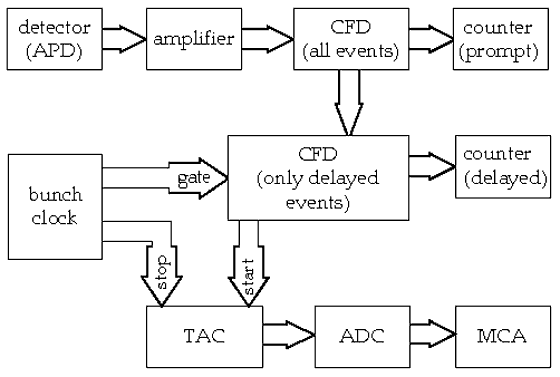- Home
- Optics elements
- Detectors and electronics
Detectors and electronics

For nuclear resonance scattering experiments detectors with ns to sub-ns time resolution, high dynamical range, and fast recovery time are mandatory. Beam intensities of 109 photons/s in the prompt pulse (i.e. 200 photons per bunch in 16-bunch mode) are common conditions. The detector must survive this intense prompt flash and be able to count few nanoseconds later a single photon event of the delayed nuclear radiation. State-of-the-art detectors are nowadays avalanche photo diode (APD) detectors.
We pushed the development of these detectors including electronics in the group. The performance can be summarized as:
-
dynamic range and linearity is assured over nine decades of intensity
-
efficiency: 40% at 14.4 keV
-
background: 0.02 photon/s
-
time resolution: 100 ps to about 1 ns
Depending of applications and energy regime stacked (up to 24) and inclined detectors are common practice in order to improve the efficiency. These detectors are now also used at other beamlines and were the basis for the development of fast counting detectors by the detector group. However, with the improvement of the synchrotron radiation sources and more demanding experimental set-ups the detector system has to follow. As a first step in this direction we inquire on the one hand the possibilities for faster detectors (< 1 ns) and on the other hand for one dimensional fast detector systems.
Additional information:
-
Pictures ( APD circuit, APD array)
Electronics

As shown in the figure below, mainly two inputs are necessary for the collection of signals: the signal from the detector (APD) in the experiment and the bunch-clock, which is a trigger signal delivered by the radio frequency signal (352.2 MHz) from the storage ring

The amplified detector signal is fed into two constant fraction discriminator (CFD) to select a timing point on each input pulse that is independent of the pulse amplitude. In reality at high prompt count rates the timing point is unfortunately not independent of the pulse amplitude, which can introduce an uncertainty of maximal 0.1ns in the determination of time zero. The outgoing signal can serve as monitor for the incident radiation (prompt signal) as long as the detector is not saturated.
Another CFD which is gated. The gate pulse is generated from the bunch clock signal. This means, that only pulses are transferred to the time to amplitude converter (TAC), which occur during this gate pulse in order to separate prompt and delayed counts. This gating procedure is necessary because the TAC can not handle the high count rates of the prompt pulse. The TAC is started by the delayed pulses and stopped by the bunch clock. The output is converted with an analog-digital-converter (ADC) and fed into a multi channel analyser (MCA), which records the time dependence of the NRS. The delayed signal from the CFD is also used to record the energy dependence (time integrated) of the NRS (delayed signal).



